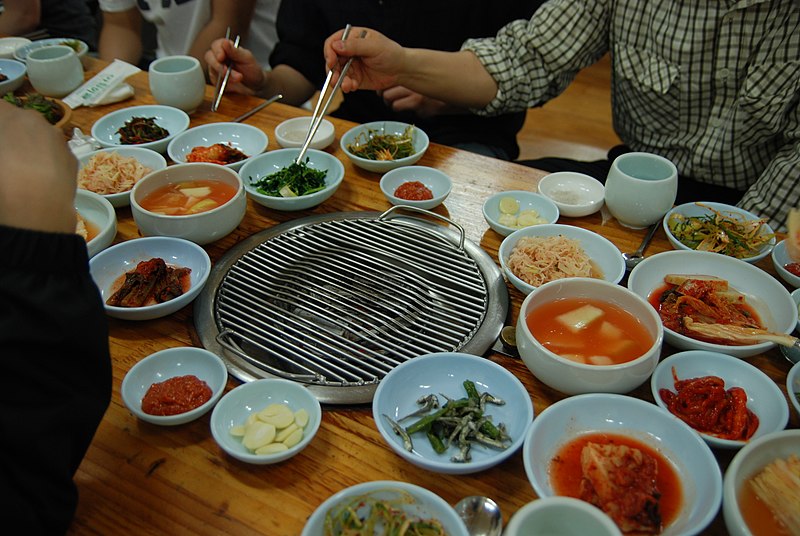Korean bbq (Barbecue) is a popular method of grilling meat such as beef, chicken, or pork, which is typical of Korean cuisine. These dishes are grilled either on gas or charcoal grills that are built into the dining table itself. They can also be grilled on portable stoves that can be used at the table. Alternatively, a central display grill is also often used by the chef to prepare dishes.

A classic Korean barbecue combines some typical components, such as banchan and bulgogi. It also includes accompaniments and refreshments that are served along with them. Korean food is meant to be a collective experience. This means that it is supposed to be enjoyed together as a community. Even non-Korean communities are now starting to enjoy this delightful cuisine.
Also Read How to make homemade healthy snickers bars at home
The components of Korean Barbecue
So whether you plan to just go out to enjoy some good Korean bbq, or you want to host an entire feast at your place, make sure you are aware of these important components.
The meat in Korean bbq

Though there are quite a few vegetarian options available too, meat is the real show stopper in Korean bbq. The chargrilled meat and the rendered fat are the classic components of a good Korean barbecue. In fact, all other components are meant to revolve around this primary central ingredient. The most commonly used meats are beef and pork. The meat could either be marinated before cooking. Or you could just season and grill the meat.
Beef: Galbi and Bulgogi
Galbi are short ribs. Ulgogi is usually made up of thinly sliced ribeye or brisket. Both of these rely on a savory-sweet sauce for their marinade. The marinade also includes Asian pears, brown sugar, sesame oil, and mirin.
Pork: Dwaeiji Bulgogi
The marinade that is used for this is much more intense and overpowering. The final dish is also paired with much fancier accompaniments.
Chicken: Buldak
For those who do not prefer pork or red meat, chicken is a good option. Just like pork, chicken is centered around a spicy-sweet sauce. As the chicken cooks, the sugars in the marinade caramelize, giving the chicken a beautiful charred look and taste.
Also Read Top 10 Classic French pastries every dessert lover needs to try
The Sauce: Ssamjang in Korean Barbecue
Irrespective of the meat that you choose, the sauce is a must to spread on your prepared food. SSamjang is a no-cook sauce, that just involves stirring together different ingredients. Traditional ingredients include soybean paste and chili paste. It also includes sesame oil, sesame seeds, fresh garlic, and scallions.
In English, SSamjang translates to ‘wrapped thick sauce’. It is basically spread on lettuce and perilla leaves. These leaves are then wrapped around the pieces of grilled meat. The quantity of the sauce to be used depends on the meat that you are using. Beef being subtle in flavor can take more amounts as compared to others.
Lettuces and Perilla Leaves: The Ssam

Lettuce and perilla leaves are used to wrap the meat parcels. Perilla leaves are quite common in Korean markets and are sold as sesame leaves. The grassy flavor of these leaves adds an excellent dimension to the grilled beef and pork.
When it comes to lettuce, leafy varieties like red leaf are common in Korean barbecue.
The leaves need to be flexible enough to be able to wrap items, but also need to be large and sturdy enough to not tear. Thus, lettuce like romaine, which snaps easily, should be avoided. Other than acting as agents that help to wrap the meat, these leaves also add a refreshing taste to the dish. Take all care to ensure that the leaves stay bright and fresh, and don’t wither away.
Garnishes
Finishing garnishes are a must in any Korean Barbecue. These are sprinkled on the bites of food before consuming them. These include scallions, sliced garlic, and fresh green chilies, served with some toasted sesame seeds.
The side dishes: Banchan served in Korean Barbecue
A spread of side dishes completes the Korean barbecue. The term ‘Banchan’ basically refers to all the small side dishes that are served along with the main barbecue meal. These side dishes help to stave away the palate fatigue that occurs after consuming all the meat. These include pickled, fermented vegetables; such as kimchi. Marinated greens like spinach are also common. Rolled omelets and stir-fried anchovies are also important side dishes.
Rice
Rice is a crucial part of Korean meals. However, when it comes to Korean barbecue, rice is more of a supporting dish. It is the meat that takes the limelight.
Beverages: Beer, Soju, Makgeolli, or Wine, served along with Korean Barbecue
Plenty of beverages are needed alongside the main meal. Moreover, Korean food will leave you feeling really thirsty and salivating. Thus, refreshments are unavoidable. Remember that drinking is also a collective activity in Korea. Thus, people pour out drinks for each other and not for themselves. It is customary to receive drinks with both hands and to drink shots as a group.
However, try and keep drinking on the lighter side. Soju and makgeolli, both milky wines made from water, rice, and the fermentation starter nuruk, are common refreshments.
Preparing your own Korean bbq

Korean Barbecue is a celebration of fire. If you plan to host your own barbecue lunch, make sure you get lots of meat and also a lot of chili! And even if you don’t have an indoor grill, it is not a problem. You can use your outdoor grill to cook your delicious barbecue. Make sure to prep and marinade your meat well. The extra effort that you do will go a long way in making your meal a delicious one. Also pay close attention to your meat, flipping it only once when it is halfway done.


Like!! Great article post.Really thank you! Really Cool.